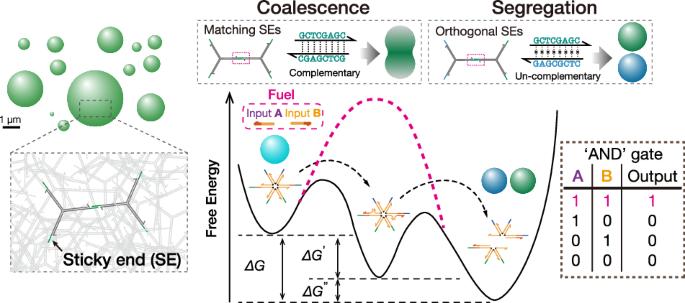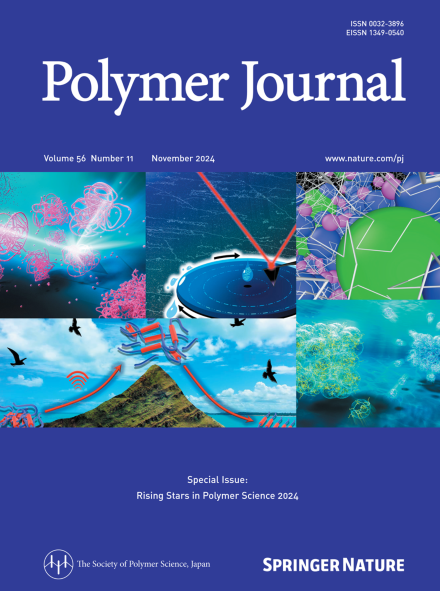Synthetic nucleic-acid droplets: a bioprogramming platform for designer microliquids
IF 2.7
4区 化学
Q3 POLYMER SCIENCE
引用次数: 0
Abstract
Research on biomolecular liquid-state condensates (droplets) in cells has sparked burgeoning interest among synthetic biologists in programmable droplets assembled from synthetic nucleic acids––information-encoding biomolecules amenable to facile synthesis, versatile sequence design, and molecular decoration. Analogous to biological condensates, well-engineered nanostructures consisting of DNA or RNA strands, which are negatively charged, phase-separate into membrane-free droplets via weak multivalent specific interactions or via electrostatic attraction with positively charged peptides. The membraneless compartments of these droplets allow stimuli responsiveness to molecular cues (DNA/RNA, enzymes, etc.). Nucleic acid droplets thus offer a powerful platform for programming their various features, including hierarchical structuring, molecular recognition capabilities, droplet interactions, and physical properties. Specifically, we describe a DNA linker that serves as a programmable surfactant bridging immiscible DNA phases, which, upon molecular inputs, alters their separation level from mixed to divided states. Furthermore, a rational combination of these features can create intelligent liquid-state architectures capable of naturally unachievable functions and dynamics, such as Boolean operations and directional motion. To predict how molecular-level encoding leads to macroscopic characteristics, coarse-grained models, which treat nucleic acids as strings of interacting rigid beads, are widely utilized. This emerging field represents a cross-disciplinary integration of various fields, from biophysics to information science. This Focus Review highlights recent advances in synthetic nucleic-acid droplets and their far-reaching potential, concluding with perspectives on their future directions and challenges. Emerging from DNA/RNA nanoengineering, synthetic nucleic-acid liquid condensates, forming via phase separation of nanostructures, have attracted increasing attention as a powerful platform for synthetic biology and molecular computing. Base-sequence specificity allows for molecular encoding for their organization, functions, and droplet interactions. Authors overview key topics of these programmable droplets, from dynamics programmability to numerical modeling. Additionally, this review highlights cross-linker modules, which enable dynamic compartmentalization and division of droplets triggered by specific molecular input. These modules allow the condensate phase behavior to represent Boolean logic operation.

合成核酸液滴:设计微液体的生物编程平台
细胞中生物分子液滴的研究引起了合成生物学家对由合成核酸组装而成的可编程液滴的兴趣,这些可编程液滴是信息编码的生物分子,易于合成、通用序列设计和分子修饰。与生物凝聚物类似,由带负电荷的DNA或RNA链组成的精心设计的纳米结构,通过弱多价特异性相互作用或与带正电荷的肽的静电吸引,相分离成无膜的液滴。这些液滴的无膜隔室允许对分子线索(DNA/RNA,酶等)的刺激反应。因此,核酸液滴提供了一个强大的平台来编程它们的各种特征,包括层次结构、分子识别能力、液滴相互作用和物理性质。具体来说,我们描述了一种DNA连接子,它作为一种可编程的表面活性剂桥接不混相的DNA相,在分子输入后,将它们的分离水平从混合状态改变为分裂状态。此外,这些特征的合理组合可以创建智能液态架构,能够实现自然无法实现的功能和动态,例如布尔运算和定向运动。为了预测分子水平编码如何导致宏观特征,将核酸视为相互作用的刚性珠子串的粗粒度模型被广泛使用。这一新兴领域代表了从生物物理学到信息科学等各个领域的跨学科整合。本文重点介绍了合成核酸液滴的最新进展及其深远的潜力,并对其未来的发展方向和挑战进行了展望。合成核酸液体凝聚体是DNA/RNA纳米工程的产物,通过纳米结构的相分离而形成,作为合成生物学和分子计算的强大平台而受到越来越多的关注。碱基序列特异性允许对其组织、功能和液滴相互作用进行分子编码。作者概述了这些可编程液滴的关键主题,从动态可编程性到数值建模。此外,本文还重点介绍了交联剂模块,它可以通过特定的分子输入触发液滴的动态区隔和分裂。这些模块允许冷凝相行为来表示布尔逻辑操作。
本文章由计算机程序翻译,如有差异,请以英文原文为准。
求助全文
约1分钟内获得全文
求助全文
来源期刊

Polymer Journal
化学-高分子科学
CiteScore
5.60
自引率
7.10%
发文量
131
审稿时长
2.5 months
期刊介绍:
Polymer Journal promotes research from all aspects of polymer science from anywhere in the world and aims to provide an integrated platform for scientific communication that assists the advancement of polymer science and related fields. The journal publishes Original Articles, Notes, Short Communications and Reviews.
Subject areas and topics of particular interest within the journal''s scope include, but are not limited to, those listed below:
Polymer synthesis and reactions
Polymer structures
Physical properties of polymers
Polymer surface and interfaces
Functional polymers
Supramolecular polymers
Self-assembled materials
Biopolymers and bio-related polymer materials
Polymer engineering.
 求助内容:
求助内容: 应助结果提醒方式:
应助结果提醒方式:


